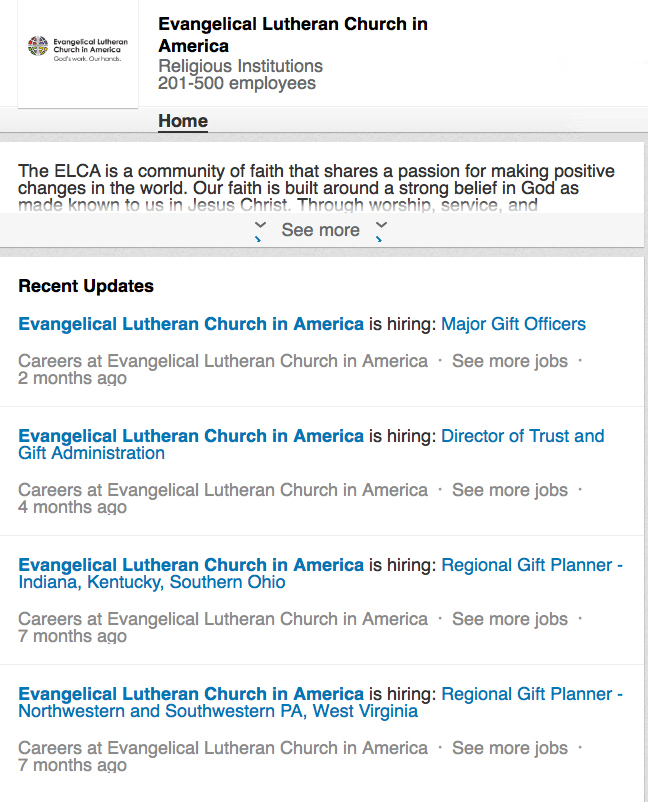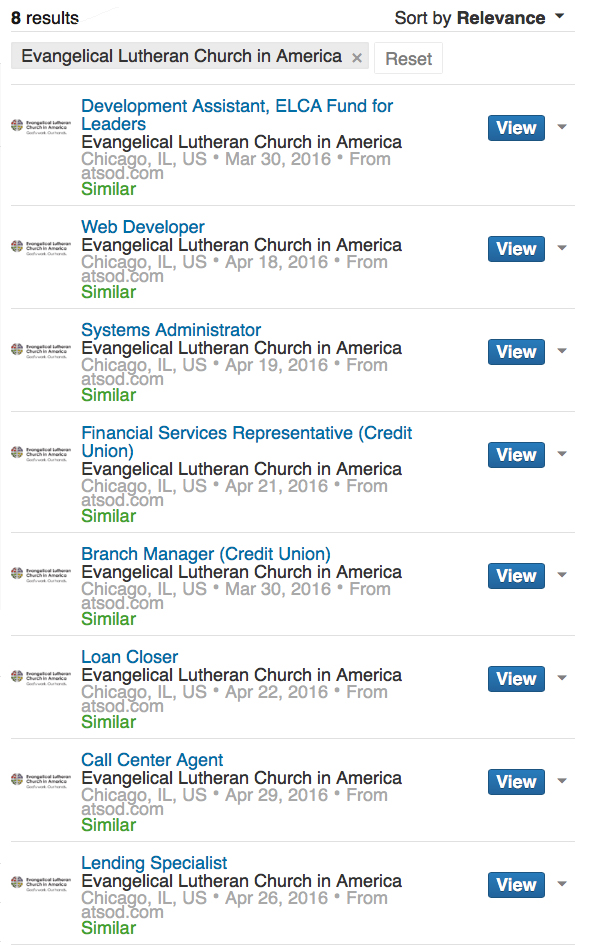How Congregations Are Funding Their Own Demise

Yesterday I stumbled across the Evangelical Lutheran Church in America’s LinkedIn page. They have some job listings. Here they are:
Notice something? Every job listing is about finding money.
I followed the link between every listing that says “See more jobs.”
Here are the additional listings.
Most of these jobs have something to do with fund-raising or asset management.
The Congregational Offering Plate Has Competition
If you don’t believe the Church is a business, think again. Offerings can no longer support the top-heavy structure created in better days. The Church is looking for talent that brings in money. Where do you think they will find it? Where do you think they will spend it?
The national and regional offices, struggling to survive, are creating development offices that bypass congregations and go directly to individuals. These individuals are most likely your most affluent members. The best potential donors are your congregation’s aging membership in need of estate planning.
Congregational money sent to the regional and national offices fund these development efforts.
Can your congregation compete with well-paid, high-level professionals? Your teachings about stewardship may be feeding into the message of these development offices.
Many of today’s churches are living on endowment funds contributed by members decades ago. Congregations, beware. Others in the Church have eyes on your future funding.
It gets even more complicated. In addition to the regional and national offices, affiliated church agencies also staff development offices. They have some independence but are also funded with congregational contributions. These include charities like relief agencies, seminaries, schools, homes for the aging, local agencies, and camps. Some church-related agencies have shadow for-profit corporations, less affiliated with the Church, that can attract grant giving and work with government programs.
That’s a lot of competition looking for the biggest slice possible from the same pie!
The Last Left Standing
As local, regional and national bodies all struggle, the Church must consider the question: Which entity should be the last standing? As decline continues, should the national church disband first or the regional body? Should they both work to get the resources from their member churches until there are only ten large congregations in each synod. (The larger the congregation the less need for synod assistance.) Should the agencies slowly forgo church affiliation (as many already have) and join the plethora of nonprofits, each with an important mission, that also court congregational members for contributions and estate planning.
This is a problem that the Church does not discuss because everyone’s status in the Church is at stake. A lot of church jobs rely on the success of development offices. In the end, the congregations, the lowest on the Church organizational totem pole (but the foundation of all funding), no longer matter. The Church as a whole looks the other way as regional bodies find ways to close churches in ways that make sure the congregation’s assets go to them. This has been going on for a while. But now, the tactic is to reach your members well in advance of them leaving their estates to the local congregation.
Congregations are funding their own demise. The Church is in the Colosseum — and we’ve been feeding the lions.
Important point: Church-related organizations are not inherently bad for looking for more funding. Everyone needs money. However, as each church-sponsored entity becomes self-focused in building its own funding base, there is less concern of how their success is impacting sponsoring congregations. The success of one agency, or the regional and national bodies means less money is available for the congregations, who are still expected to send funds their way via the offering plate. This is particularly unfair with Church social service agencies, many of whom have positioned themselves to benefit from government funding—a pie that most congregations assume they cannot tap. Objections that efforts in that direction sidetrack the prime objective of Christian community are legitimate. The proof is in what has become of church agencies who took this track 30 or more years ago. Lutheran colleges/universities have little connection with Lutheranism today. Lutheran social services take care to avoid displaying Christian connections. When our congregation rented space to a Lutheran agency for a day school, they turned around the Christian images hanging on our walls.


